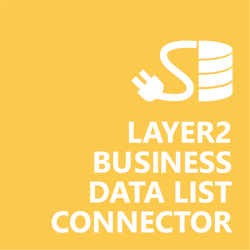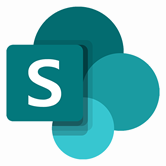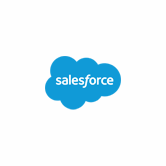Keep your Sharepoint in sync. Download and try today.
Salesforce SharePoint Integration
Salesforce data can be integrated codeless with native SharePoint lists using the Layer2 Business Data List Connector. You can also connect to 100+ more supported systems and applications. In case you are looking for Online data integration, you will find the right tool here.
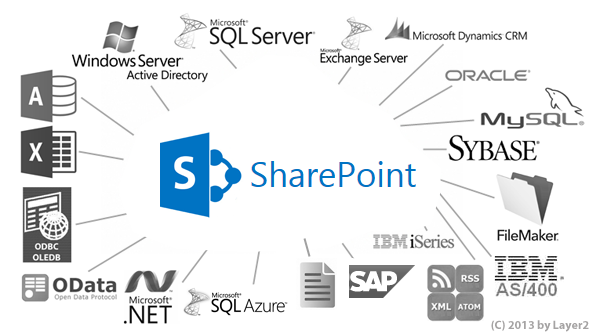
Benefits of Salesforce Integration in SharePoint
Salesforce data integration in SharePoint has the following features and benefits:
- Very easy to setup in a few minutes: Create a SharePoint list, click "Connect to external data source" in the list settings, select the data provider, enter connection settings and data query as shown below. That's it.
- No changes in the Salesforce data source required: No programming, no additional tools.
- Connected list data always up-to-date: The connected Salesforce data query updates automatically in background (via SharePoint Timer Job), or alternatively, on-demand (Action Menu / Ribbon Button, URL, via workflow, API).
- One-way and optional two-way connection: You can write-back the changes made in the SharePoint list to the external Salesforce data source automatically with full CRUD (Create / Update / Delete) functionality. The SharePoint list can act as a full-featured front-end for external systems.
- Well-known BCS external list issues and limitations are completely solved: ALL list features are to you. Views, sorting and grouping, filters, calculated fields, search, managed metadata. Lookups, additional columns and attachments can be created as normal. All kind of lists can be used, e.g. contacts, tasks, calendar, or custom lists. You can take external data offline via Outlook.
- Workflows and notifications on external data change: List workflows and change notifications per RSS or email can be used to take business actions in SharePoint, when external Salesforce data records are changed.
- Application logging, reporting, and notifications: A SharePoint list is used to store settings and log information. SharePoint item versioning and workflows can be used to manage reporting and notifications. Direct notification per email in case of errors is supported as well.
- Highest Security, best performance, easy to maintain: SharePoint Secure Store can be used to store security relevant configuration information safely in one central place. Users are working with the SharePoint lists as an external data cache with highest security and performance. Large data sources can be synchronized.
- 100+ more external systems supported: Layer2 Data Providers included (e.g. for external SharePoint or Office 365, Exchange, Dynamics ERP/CRM, OData, XML/RSS, SOAP), vendor specific data providers can be used (e.g. SQL Server Oracle, MySQL etc.), 3rd party data providers also supported, e.g. for custom ERP/CRM, Facebook or Twitter. See here for supported systems and applications.
Salesforce Specific SharePoint List Configuration Settings
In the SharePoint General List Settings click "Connect to external data source". In the BDLC list configuration form, the data source must be configured as follows to connect to Salesforce using the ODBC Data Provider (this example specifically shows the settings for Data Direct).
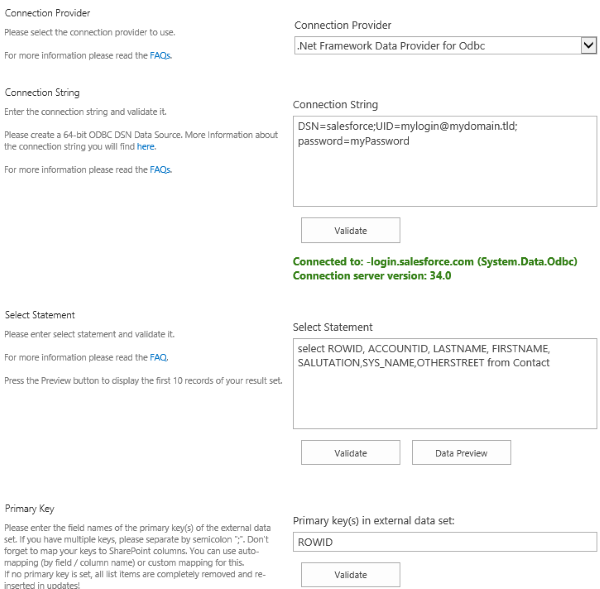
Figure 1: Example connection configuration to connect a native SharePoint list to an Salesforce data source.
Please note the following about specific settings:
- You will need 3rd party data providers to connect to Salesforce via BDLC.
- Progress offers an ADO.NET data provider for Salesforce that allows for write-back with BDLC. See this blog entry about how to connect via Progress DataDirect Driver for Salesforce and ODBC.
- DevArt also offers an that works with BDLC (read-only).
- Note that the provider must be 64-bit to work with BDLC.
- The connection string depends on data provider. Please find documentation at the providers' site or ask the vendor.
- Retrieve a security token from Salesforce.
- The data query depends on data provider. typically SQL-like select statements are supported to query Salesforce data entities.
- You can map the resulting data fields to specific external fields in the Layer2 Cloud Connector. Please take care about data types (simple type conversions are supported).
- Please enter an appropriate primary key (column with unique values), depending on query (see data preview for this).
- You can use write-back to synchronize data back to Salesforce. In case of inserts (full CRUD) via external systems, please take care of the primary key. Salesforce-side IDs will not work in his case.
- No installation or changes are required at the Salesforce data source or data destination.
- No programming required for setup a connection and sync.
- No need to open your local network for access from outside.
Do you have questions or issues connecting? Please contact [email protected] directly.
Data Direct ODBC Data Provider Connection Details
Provider:
.net
Framework Provider for Odbc
(You will need to configure the ODBC provider per the Vendor's instructions)
Connection string sample:
DSN=Salesforce; [email protected]; Password=myPassword;
Select Statement sample:
SELECT myField1, myField2 FROM
myTable
For additional information, see the Data Direct User Documentation.
SharePoint Integration via Salesforce - Examples, Known Issues and Workarounds
The integration of Salesforce-related data sources in SharePoint has the following known issues and workarounds:
- In case of any issues with the dotConnect .NET data provider you can also go the ODBC way to connect to FileMaker. See this blog entry about how to connect via Progress DataDirect Driver for Salesforce and ODBC. You will find a more general step-by-step intro about Cloud Connector and ODBC here.
- The Data Direct provider from Progress caches the schema for the Saleforce fields. After adding a new field, you may not be able to find it with the select statement (error [42S22] Column Not Found in Statement) as the cache is stale. To update it, go to the ODBC driver settings on the host machine, click on the Advanced tab, and check the box for the option "Refresh Schema". Save the DSN and try to access the data again. The schema should refresh and the column will be available.
- The DevArt Dotconnect provider caches schema for the Salesforce fields. After adding a new field you do not see it in the data preview or the mapping, you may need to clear the cache. The caching functionality is explained here and you will need to delete the cache files, usually located here: C:\Users\{user name}\AppData\Roaming
- The Data Direct provider from Progress has some odd behavior regarding using "Select *" for the select statement in a connection that writes back TO SalesForce. It will throw an error "[HY000]...Unable to create/update fields", unless you specifically select which fields you want to pull in the table.
- Not all versions of Salesforce have the API functionality available. If you are using a version that doesn't have it available, then you will get an error "API_DISABLED_FOR_ORG". Please see Salesforce Help's document Enabling API for more information on which versions have the API functionality and what to do if you need it enabled.
Ready to go next steps?

